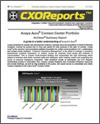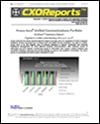September 04, 2009
U.S. Residential Broadband Speeds On the Rise � Slowly, But Surely
 By Vivek Naik, TMCnet Contributor
By Vivek Naik, TMCnet Contributor
In a recent comparison of surveys on U.S. consumer broadband speeds, In-Stat reportedly said It agrees with most of the Communications Workers of America’s findings, but questions a few of the firm’s conclusions.
Research analysts at the firm said CWA (News - Alert) discovered that the average Internet download speed in the US has improved, but it is still slower than in 27 other countries. According to the CWA’s study, the average download Internet speed in the US is 5.1 Mega bits per second in 2009, an increase of only 1.6 Mbps, from 2007 and that it would take the US 15 years to catch up with current Internet speeds in South Korea.
In-Stat (News - Alert) said that on comparison to its study called “U.S. Residential Broadband Speeds on the Rise,” it found a slight, but insignificant, deviation in the average download speed, which it found to be 5.6 Mbps when compared with CWA’s 5.1 Mbps. Officials said while most people acknowledge the importance of speedy broadband connection, it has been hard to compare and contrast the actual bandwidth available in the United States.
Officials, however, said that national broadband speeds are determined by population density and population distribution, it is much easier to deliver higher speed broadband services in ultra dense metropolitan areas like Tokyo or Seoul than it is in suburban or rural areas of the US, where the majority of the population resides.
It is also important to consider the geographic area of different countries before jumping to quick conclusions. For example, the U.S. has a total area of 9.8 million square km, or 3.7 million square miles, whereas South Korea has a mere 100,140 square km, or 38,622 square miles, which is only 1 percent of USA’s area. Meanwhile, Japan has 145,883 square miles, which is only 3.8 percent of USA’s area. So ramping up high speed broadband infrastructure is a cakewalk for such small nations compared to the challenges that the US faces.
In-Stat said that the CWA said the association and its members stand to benefit from any increase in public or private expenditures on broadband networks and services since, “a lot of federal stimulus money could be on the line.” However, there is well-though out and structured approach by the government towards tackling the herculean task of taking broadband to each and every populated nook and cranny of the US.
The American Recovery and Reinvestment Act (ARRA) 2009 - also called the Federal Stimulus Package – was signed into Law by President Barack Obama on Feb. 17, and reportedly has set $7.2 billion for the development of broadband and Wi-B in USA and $350 million from this fund reservoir is earmarked for Broadband Data Improvement Act of 2008. $2.5 Billion of the $7.2 billion is set aside for low-interest loans, loan guarantees and grants at U.S. Department of Agriculture's Rural Development and Utilities services Program Broadband Initiatives Program discretion and that the remaining $4.7 Billion is allotted for the Department of Commerce’s National Telecommunications and Information Administration’s Broadband Technology Opportunities Program to decide on grants to deserving companies and technologies via its Broadband Technology Opportunities Program.
In addition, there is another $1.3 billion reportedly set aside in the form of loans and grants to enhance broadband and telecommunications services in rural areas within the federal budget for the fiscal year 2010. Most of the above mentioned funds have been designated to help expand broadband access to unserved and underserved communities across the U.S.
RUS will reportedly not fund more than one project to serve any given geographic area, and its bylaws deem that grants, loans or loan guarantees, can only be used for projects wherein at least 75 percent of a funded area is in a rural area that lacks sufficient high speed broadband service to facilitate economic development.
Connected Nation (News - Alert), NTIA and RUS had recently reportedly presented its progress, status and recommendations reports about facilitating every American citizen with broadband infrastructure as per the directives mentioned in ARRA 2009 to the House Committee on Energy and Commerce, Subcommittee on Communications, Technology, and the Internet.
The overall agreement reportedly was that the best and most progressive results happened when the government and private companies collaborated to expand and set up broadband related infrastructure. There was also a heavy emphasis that collaborative efforts would enable companies and countries to come out of financial tailspin that the entire world is in, and it was listed as one of the seven critical Consumer Electronic Show 2009 guidelines.
The five core purposes reportedly defined in Section 6001 of ARRA to establish a national broadband service development and expansion program include: To provide access to broadband service to consumers residing in un-served areas of the country; To provide improved access to broadband service to consumers residing in underserved areas of the country; To provide broadband access, education, awareness, training, equipment, and support to community anchor institutions such as schools, libraries, medical facilities, or organizations and agencies serving vulnerable populations such as low-income, unemployed, aged, or job-creating strategic facilities located in state or federally designated economic development areas; To improve access to, and use of, broadband service by public safety agencies; and, To stimulate the demand for broadband, economic growth, and job creation.
RUS will favor funding projects that can, among other things, commence construction promptly and demonstrate technical and financial feasibility, organizational capacity, and compliance with other Administration priorities.
The Rural Mobile Broadband Alliance of the United States of America, or RuMBA USA had reportedly launched the RuMBA (News - Alert) American Broadband Bill of Rights that throws the voice of the people behind the ARRA initiative, which primarily desires that all Americans, especially unserved, rural and underprivileged citizens must have the maximum possible continuous access to wired broadband and Wi-B as soon as possible since broadband is gaining in popularity and it is expected to expose potential users to the same wealth of information, ideation and opportunity that existing users experience.
In-Stat said that the CWA said the association and its members stand to benefit from any increase in public or private expenditures on broadband networks and services since, “a lot of federal stimulus money could be on the line.” However, there is well-though out and structured approach by the government towards tackling the herculean task of taking broadband to each and every populated nook and cranny of the US.
In-Stat said another point to be considered is that broadband speeds are often a function of demand, something that is usually ignored in these country comparisons. Consumer demand for faster broadband services almost always drives increases in bandwidth. In-Stat’s February report on broadband services showed that 78 percent of US broadband subscribers were “satisfied” with the speed of their current broadband connection. So while there are countries where demand for higher broadband speeds is strong, In-Stat does not see that kind of demand in the U.S.
Follow ITEXPO (News - Alert) on Twitter: twitter.com/itexpo
Vivek Naik is a contributing editor for TMCnet. To read more of Vivek's articles, please visit his columnist page.
Edited by Amy Tierney














